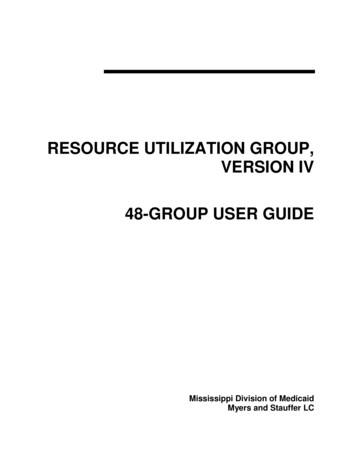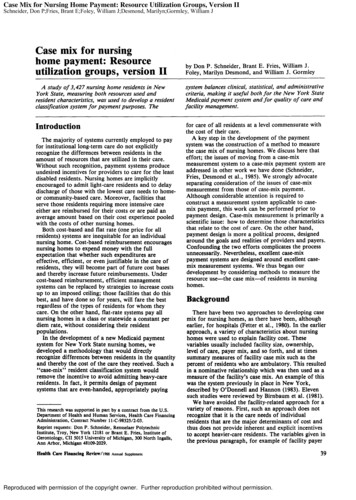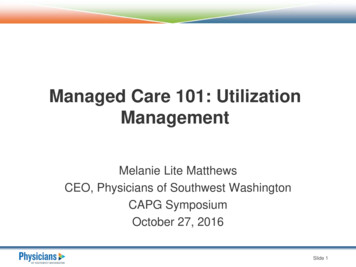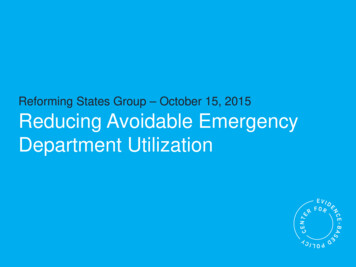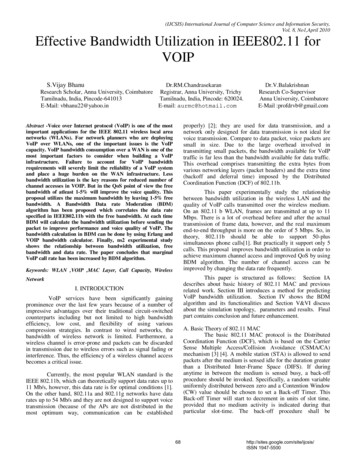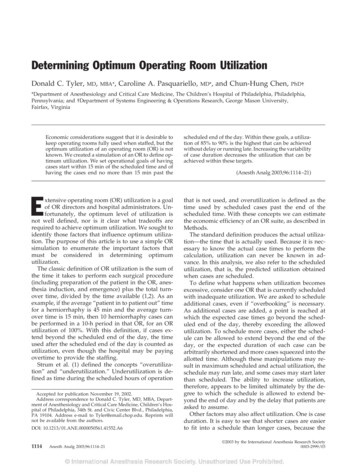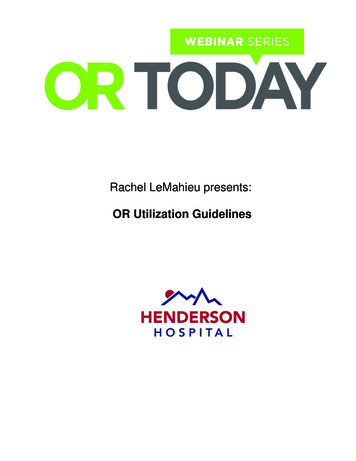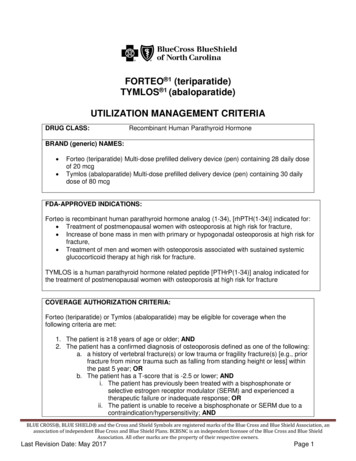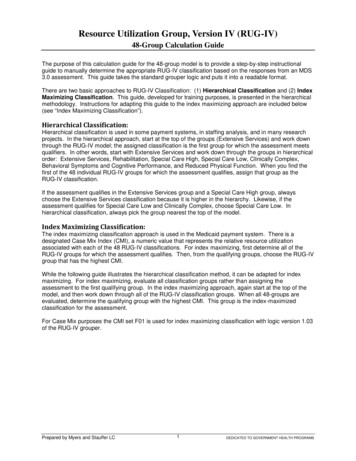
Transcription
Resource Utilization Group, Version IV (RUG-IV)48-Group Calculation GuideThe purpose of this calculation guide for the 48-group model is to provide a step-by-step instructionalguide to manually determine the appropriate RUG-IV classification based on the responses from an MDS3.0 assessment. This guide takes the standard grouper logic and puts it into a readable format.There are two basic approaches to RUG-IV Classification: (1) Hierarchical Classification and (2) IndexMaximizing Classification. This guide, developed for training purposes, is presented in the hierarchicalmethodology. Instructions for adapting this guide to the index maximizing approach are included below(see “Index Maximizing Classification”).Hierarchical Classification:Hierarchical classification is used in some payment systems, in staffing analysis, and in many researchprojects. In the hierarchical approach, start at the top of the groups (Extensive Services) and work downthrough the RUG-IV model; the assigned classification is the first group for which the assessment meetsqualifiers. In other words, start with Extensive Services and work down through the groups in hierarchicalorder: Extensive Services, Rehabilitation, Special Care High, Special Care Low, Clinically Complex,Behavioral Symptoms and Cognitive Performance, and Reduced Physical Function. When you find thefirst of the 48 individual RUG-IV groups for which the assessment qualifies, assign that group as theRUG-IV classification.If the assessment qualifies in the Extensive Services group and a Special Care High group, alwayschoose the Extensive Services classification because it is higher in the hierarchy. Likewise, if theassessment qualifies for Special Care Low and Clinically Complex, choose Special Care Low. Inhierarchical classification, always pick the group nearest the top of the model.Index Maximizing Classification:The index maximizing classification approach is used in the Medicaid payment system. There is adesignated Case Mix Index (CMI), a numeric value that represents the relative resource utilizationassociated with each of the 48 RUG-IV classifications. For index maximizing, first determine all of theRUG-IV groups for which the assessment qualifies. Then, from the qualifying groups, choose the RUG-IVgroup that has the highest CMI.While the following guide illustrates the hierarchical classification method, it can be adapted for indexmaximizing. For index maximizing, evaluate all classification groups rather than assigning theassessment to the first qualifying group. In the index maximizing approach, again start at the top of themodel, and then work down through all of the RUG-IV classification groups. When all 48-groups areevaluated, determine the qualifying group with the highest CMI. This group is the index-maximizedclassification for the assessment.For Case Mix purposes the CMI set F01 is used for index maximizing classification with logic version 1.03of the RUG-IV grouper.Prepared by Myers and Stauffer LC1DEDICATED TO GOVERNMENT HEALTH PROGRAMS
Resource Utilization Group, Version IV (RUG-IV)48-Group Calculation GuideCategory2-16IYesExtensiveServicesTrach AND VentES3ES3 3.00Trach OR VentES2ES2 2.23ES1ES1 2.22RAERAE 1.65RADRAD 1.58RACRAC 1.36RABRAB 1.10RAARAA ed11-14Depressed6-10DepressedIII & 4DepressedADLLE2NoYesDepressed2-5DepressedLC2 1.30LC1 sADL2 2 1BB2 0.81BB1 0.75BA1BA2 0.58BA1 0.530-12 0-12 0-1PD2 1.15PD1 1.06PC1PC2 0.91PC1 0.85PB1PB2 0.70PB1 0.65PB2PA2PA1DelinquentPrepared by Myers and Stauffer LC2PE2 1.25PE1 1.17PD1PC22 Restorative NursingCA2 0.73CA1 0.65PE10-1Restorative NursingRestorative NursingCA1PD22 Restorative Nursing2-5CB2 0.95CB1 0.85PE20-1Restorative Nursing1CB1BA20-1Restorative NursingNoCC2 1.08CC1 0.96CA20-1Restorative Nursing0-1CC1CB2BB22 VICD2 1.29CD1 1.15CC2No2-5CD1NoYesNoBehavioralSymptoms &CognitivePerformanceCE2 1.39CE1 1.25CD2YesLB2 1.21LB1 0.95CE1CE2NoDepressed15-16LE2 1.61LE1 1.26LC1LC2No1.691.331.571.231.551.22LD2 1.54LD1 1.21NoYesHD2HD1HC2HC1HB2HB1LD1LD2NoYes6-10LE1HE2 1.88HE1 1.47PA2 0.49PA1 0.45BC1 0.45DEDICATED TO GOVERNMENT HEALTH PROGRAMS
Calculation of “ADL” ScoreRUG-IV, 48-Group Hierarchical ClassificationThe Activities of Daily Living (ADL) score is a component of the calculation for placement in all RUG-IVgroups. The ADL score is based upon the four “late loss” ADLs (bed mobility, transfer, toilet use, andeating). This score indicates the level or functional assistance of support required by the resident and is avital component of the classification process.Step #1:To calculate the ADL score use the following chart for bed mobility (G0110A), transfer (G0110B), andtoilet use (G0110I) and record the ADL score for each:Self-PerformanceColumn 1 AndSupport ProvidedColumn 2 ADLScore -, 0, 1, 7 or 8and-, 0, 1, 2, 3 or 80Bed Mobility 2and-, 0, 1, 2, 3 or 81Transfer 3and-, 0, 1 or 22Toilet Use 4and-, 0, 1 or 233 or 4and34Record ScoreStep #2:To calculate the ADL score for Eating (G0110H), use the following chart and record the ADL score foreating:Self-PerformanceColumn 1 AndSupport ProvidedColumn 2 ADLScore -, 0, 1, 2, 7 or 8and-, 0, 1 or 80-, 0, 1, 2, 7 or 8and2 or 323 or 4and-, 0 or 123and2 or 334and2 or 34Record ScoreEating Step #3:Sum the scores for Bed Mobility, Transfer, Toilet Use and Eating to determine the total ADL score. Thetotal ADL score ranges from 0 through 16; a score of 0 represents independence whereas a score of 16represents total dependence.Record Total ADL ScoreThe other ADLs are also very important, but the research indicates that the late loss ADLs predictresource use most accurately. The early loss ADLs do not significantly change the classificationhierarchy or add to the prediction of resource use.Prepared by Myers and Stauffer LC3DEDICATED TO GOVERNMENT HEALTH PROGRAMS
Category I: Extensive ServicesRUG-IV, 48-Group Hierarchical h AND VentES3ES3 3.00Trach OR VentES2ES2 2.23ES1ES1 2.222-16IsolationDetermine whether the assessment is coded for at least one of the following conditions or services:Extensive Services Conditions or ServicesO0100E, 2Tracheostomy care (while a resident)O0100F, 2Ventilator or respirator (while a resident)O0100M, 2Infection isolation (while a resident)Step #1:A. If the assessment is not coded with one of the above conditions or services, skip to Category II,Rehabilitation.B. If the assessment is coded with at least one of the above conditions or services, and the ADL score is0 or 1, skip to Category V, Clinically Complex (CA1 or CA2), Step #2.C. If the assessment is coded with at least one of the above conditions or services, and the ADL score is2 or more, the assessment classifies as Extensive Services; proceed to Step #2.Step #2:The final classification for Extensive Services is based on the following chart:Extensive Service Conditions or Services (while a resident)A. Tracheostomy care and ventilator/respiratorB. Tracheostomy care or ventilator/respiratorC. Infection isolation without tracheostomy care and withoutventilator/respiratorRUG-IV ClassES3ES2ES1CMI3.002.232.22Extensive Services ClassificationPrepared by Myers and Stauffer LC4DEDICATED TO GOVERNMENT HEALTH PROGRAMS
Category II: RehabilitationRUG-IV, 48-Group Hierarchical Classification15-1611-14IIRehabilitationYesRAERAE 1.65RADRAD 1.58RACRAC 1.36RABRAB 1.10RAARAA 0.826-10ADL2-50-1Rehabilitation classification is any combination of the disciplines of licensed speech-language pathology,occupational therapy or physical therapy services. Restorative Nursing programs are also considered forthe low intensity therapy level.Determine whether the assessment is coded for therapy minutes and days:O0400 TherapiesO0400A - Speech-Language Pathology and Audiology ServicesO0400A, 1Individual MinutesO0400A, 2Concurrent MinutesO0400A, 3Group MinutesO0400A, 4DaysO0400B - Occupational TherapyO0400B, 1Individual MinutesO0400B, 2Concurrent MinutesO0400B, 3Group MinutesO0400B, 4DaysO0400C - Physical TherapyO0400C, 1O0400C, 2O0400C, 3O0400C, 4Individual MinutesConcurrent MinutesGroup MinutesDaysStep #1:A. If the assessment is not coded for therapy minutes and days, skip to Category III, Special CareHigh.B. If the assessment is coded for therapy minutes and days, calculate and sum the total therapyminutes. If the total sum of therapy minutes is less than 45 minutes, the resident does notclassify in the Rehabilitation Category; skip to Category III, Special Care High.C. If the assessment is coded for therapy minutes and days, and the total sum of therapy minutes isequal to or greater than 45 minutes, use the following criteria to determine the RehabilitationClassification.Prepared by Myers and Stauffer LC5DEDICATED TO GOVERNMENT HEALTH PROGRAMS
Category II: RehabilitationRUG-IV, 48-Group Hierarchical ClassificationStep #1 C continued:(1) Received 150 or more minutes andAt least 5 distinct days of any combination of the 3 disciplines, proceed to Step #3.OR(2) Received 45 or more minutes andAt least 3 distinct days of any combination of the 3 disciplines and2 or more restorative nursing programs received for 6 or more days,proceed to Step #2.Step #2:Determine Restorative Nursing Program Count.Count the number of restorative nursing programs provided for 6 or more days:Restorative Nursing ProgramsH0200CH0500Current toileting program or trial#Bowel toileting program#O0500AO0500BRange of motion (passive)#Range of motion (active)#O0500CO0500DO0500FSplint or brace assistanceBed mobility#Walking#O0500ETransferO0500GDressing and/or groomingO0500HEating and/or swallowingO0500IAmputation/Prosthesis careO0500JCommunication# For RUG classification count as one program even if both providedRecord Restorative Nursing Program Count:Proceed to Step #3.Step #3:The final classification for Rehabilitation is based on the following chart:ADL Score15 - 1611 - 146 - 102- 50- 1RUG-IV itation ClassificationPrepared by Myers and Stauffer LC6DEDICATED TO GOVERNMENT HEALTH PROGRAMS
RUG-IV, 48-Group Hierarchical ClassificationCategories I & II2-16IExtensiveServicesYes2-16ADLTrach AND VentES3ES3 3.00Trach OR VentES2ES2 2.23ES1ES1 2.22RAERAE 1.65RADRAD 1.58RACRAC 1.36RABRAB 1.10RAARAA 10ADL2-50-1Prepared by Myers and Stauffer LC7DEDICATED TO GOVERNMENT HEALTH PROGRAMS
Category III: Special Care HighRUG-IV, 48-Group Hierarchical ressedYesDepressedNoHD1HC2HC1HB2HB1HE2 1.88HE1 rmine if the assessment is coded for one of the following conditions or services:Special Care High Conditions or ServicesB0100Comatose with ADL Self-Performance dependencycoded 4 or 8 for all late loss ADLsI2100SepticemiaDiabetes Mellitus (DM) with both of the following:Insulin injections for all 7 daysInsulin order changes on 2 or more daysQuadriplegia with ADL score of 5 or J1550BK0300, 1 or 2K0510B, 1 or 2K0510A, 1 or 2O0400D, 2Chronic Obstructive Pulmonary Disease (COPD) withShortness of breath when lying flatFever with one of the following:PneumoniaVomitingWeight LossFeeding Tube with requirements*Parenteral/IV FeedingRespiratory Therapy for all 7 days*Tube feeding requirements:(1) Proportion of total calories received through parenteral or tube feeding(K0710A3) is 51% or more of total calories during entire periodOR(2) Proportion of total calories received through parenteral or tube feeding(K0710A3) is 26% to 50% of total calories and average fluid intake perday (K0710B3) is 501 cc or more during entire periodStep 1:A. If the assessment does not have one of these conditions or services coded, skip to Category IV,Special Care Low.B. If the assessment does have one of these conditions or services coded and the ADL score is 0 or 1,the assessment classifies as Clinically Complex; skip to Category V, Clinically Complex (CA1 orCA2), Step #2.C. If the assessment does have one of these conditions or services coded and the ADL score is 2 ormore (with the exception of Comatose which requires total dependency and Quadriplegia whichrequires an ADL score of 5 or higher), the assessment classifies as Special Care High; proceed toStep #2.Prepared by Myers and Stauffer LC8DEDICATED TO GOVERNMENT HEALTH PROGRAMS
Category III: Special Care HighRUG-IV, 48-Group Hierarchical ClassificationStep #2:This step evaluates for depression. Signs and symptoms of depression are used as a third-level split forthe Special Care High category. Assessments indicating signs and symptoms of depression areidentified by the Resident Mood Interview (PHQ-9 ) or the Staff Assessment of Resident Mood (PHQ-9OV ). Instructions for completing the PHQ-9 are in the RAI Manual (Chapter 3, Section D).The following MDS items comprise the Resident Mood Interview PHQ-9 and Staff Assessment ofResident Mood (PHQ-9-OV ):ResidentInterviewResident Mood Symptom FrequencyStaffAssessmentD0200A, 2Little interest or pleasure in doing thingsD0500A, 2D0200B, 2Feeling (or appearing) down, depressed, orhopelessD0500B, 2D0200C, 2Trouble falling or staying asleep, or sleeping toomuchD0500C, 2D0200D, 2Feeling tired or having little energyD0500D, 2D0200E, 2Poor appetite or overeatingD0500E, 2D0200F, 2Feeling bad about yourself – or that you are afailure or have let yourself or your family downD0500F, 2D0200G, 2Trouble concentrating on things, such as reading orwatching TVD0500G, 2D0200H, 2Moving or speaking slowly that others have noticedor being fidgety or restless; moving around a lotmore than usualD0500H, 2D0200I, 2Thoughts better off dead or hurting selfD0500I, 2NABeing short-tempered, easily annoyedD0500J, 2D0300Total Severity ScoreThese items are used to calculate a Total SeverityScore; Item D0300 for the resident interview andItem D0600 for the staff assessment.D0600The assessment indicates depression for RUG-IV classification if:A. The Total Severity Score PHQ-9 (D0300), which includes items D0200A-I (Resident Interview), isgreater than or equal to 10 but not 99ORB. The Total Severity Score PHQ-9-OV (D0600), which includes items D0500A-J (Staff Assessment),is greater than or equal to 10Resident is considered depressed:Prepared by Myers and Stauffer LC9YesNoDEDICATED TO GOVERNMENT HEALTH PROGRAMS
Category III: Special Care HighRUG-IV, 48-Group Hierarchical ClassificationStep #3:The final classification for Special Care High is based on the following chart:ADL Score15 - 1615 - 1611 - 1411 - 146 - 106 - 102- 52- 5DepressedYesNoYesNoYesNoYesNoRUG-IV 571.231.551.22Special Care High ClassificationPrepared by Myers and Stauffer LC10DEDICATED TO GOVERNMENT HEALTH PROGRAMS
RUG-IV, 48-Group Hierarchical ClassificationCategories I, II & III2-16IExtensiveServicesYes2-16ADLTrach AND VentES3ES3 3.00Trach OR VentES2ES2 2.23ES1ES1 10ADLRAERAE 1.65RADRAD 1.58RACRAC 1.36RABRAB 1.10RAARAA dDepressedHE1YesNoHD1HC2HC1HB2HB1Prepared by Myers and Stauffer LC11HE2 1.88HE1 CATED TO GOVERNMENT HEALTH PROGRAMS
Category IV: Special Care LowRUG-IV, 48-Group Hierarchical LD2LD1LC1LC2 1.30LC1 541.21LB2 1.21LB1 0.95Determine if the assessment is coded for one of the following conditions or services:Special Care Low Conditions or ServicesI4400Cerebral Palsy with ADL score of 5 or higherI5200Multiple Sclerosis (MS) with ADL score of 5 or higherI5300Parkinson’s Disease with ADL score of 5 or higherI6300O0100C, 2Respiratory Failure withOxygen therapy (while a resident)Feeding tube with requirements*K0510B, 1 or 2M0300C, 1Two or more Stage 2 pressure ulcers with two or more selected skintreatments**Stage 3 pressure ulcer with two or more selected skin treatments**M0300D, 1Stage 4 pressure ulcer with two or more selected skin treatments**M0300F, 1Unstageable-Slough and/or eschar with two or more selected skintreatments**M1030Two or more Venous/Arterial ulcers with two or more selected skintreatments**M0300B, 1M1030One Stage 2 pressure ulcer andOne Venous/Arterial ulcer with two or more selected skin treatments**M1040AM1200IM1040CM1200IInfection of the foot withApplication of dressing to feetDiabetic foot ulcer withApplication of dressing to feetOther open lesion on the foot withApplication of dressing to feetO0100B, 2Radiation treatment (while a resident)O0100J, 2Dialysis treatment (while a resident)M0300B, 1M1040BM1200I*Tube feeding requirements:(1) Proportion of total calories received through parenteral or tube feeding (K0710A3) is 51%or more of total calories during entire periodOR(2) Proportion of total calories received through parenteral or tube feeding (K0710A3) is 26%to 50% of total calories and average fluid intake (K0710B3) is 501 cc or more duringentire periodPrepared by Myers and Stauffer LC12DEDICATED TO GOVERNMENT HEALTH PROGRAMS
Category IV: Special Care LowRUG-IV, 48-Group Hierarchical Classification**Selected Skin Treatments for Special Care LowM1200AM1200BPressure reducing device for chair#Pressure reducing device for bed#M1200CM1200DTurning/repositioning programNutrition or hydration intervention to manage skin problemsM1200EPressure ulcer careM1200GApplication of non-surgical dressing (other than to feet)M1200HApplication of ointment/medication (other than to feet)# For RUG classification count as one treatment even if both are providedStep 1:A. If the assessment does not have one of these conditions or services coded, skip to Category V,Clinically Complex.B. If the assessment does have one of these conditions or services coded and the ADL score is 0 or 1,the assessment classifies as Clinically Complex; skip to Category V, Clinically Complex (CA1 orCA2), Step #2.C. If the assessment does have one of these conditions or services coded and the ADL score is 2 ormore (with the exception of Cerebral Palsy, Multiple Sclerosis and Parkinson’s Disease whichrequires an ADL score of 5 or higher), the assessment classifies as Special Care Low; proceed toStep #2.Prepared by Myers and Stauffer LC13DEDICATED TO GOVERNMENT HEALTH PROGRAMS
Category IV: Special Care LowRUG-IV, 48-Group Hierarchical ClassificationStep #2:This step evaluates for depression. Signs and symptoms of depression are used as a third-level split forthe Special Care Low category. Assessments indicating signs and symptoms of depression are identifiedby the Resident Mood Interview (PHQ-9 ) or the Staff Assessment of Resident Mood (PHQ-9-OV ).Instructions for completing the PHQ-9 are in the RAI Manual (Chapter 3, Section D).The following MDS items comprise the Resident Mood Interview PHQ-9 and Staff Assessment ofResident Mood (PHQ-9-OV ):ResidentInterviewResident Mood Symptom FrequencyStaffAssessmentD0200A, 2Little interest or pleasure in doing thingsD0500A, 2D0200B, 2Feeling (or appearing) down, depressed, orhopelessD0500B, 2D0200C, 2Trouble falling or staying asleep, or sleeping toomuchD0500C, 2D0200D, 2Feeling tired or having little energyD0500D, 2D0200E, 2Poor appetite or overeatingD0500E, 2D0200F, 2Feeling bad about yourself – or that you are afailure or have let yourself or your family downD0500F, 2D0200G, 2Trouble concentrating on thingsD0500G, 2D0200H, 2Moving or speakin
designated Case Mix Index (CMI), a numeric value that represents the relative resource utilization associated with each of the 48 RUG-IV classifications. For index maximizing, first determine all of the RUG-IV groups for which the assessment qualifies. Then, from the qualifying groups, choose the RUG-IV group that has the highest CMI.
